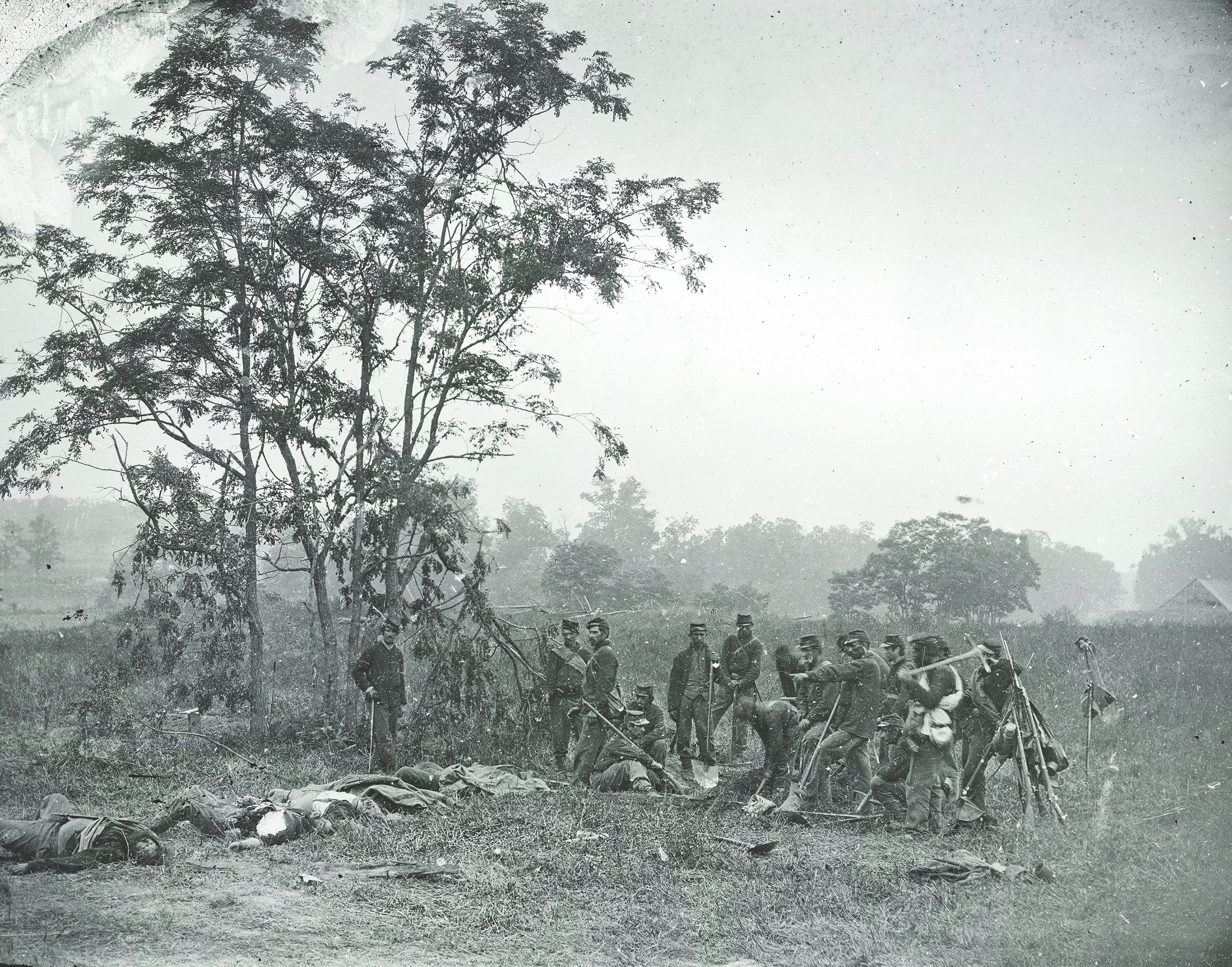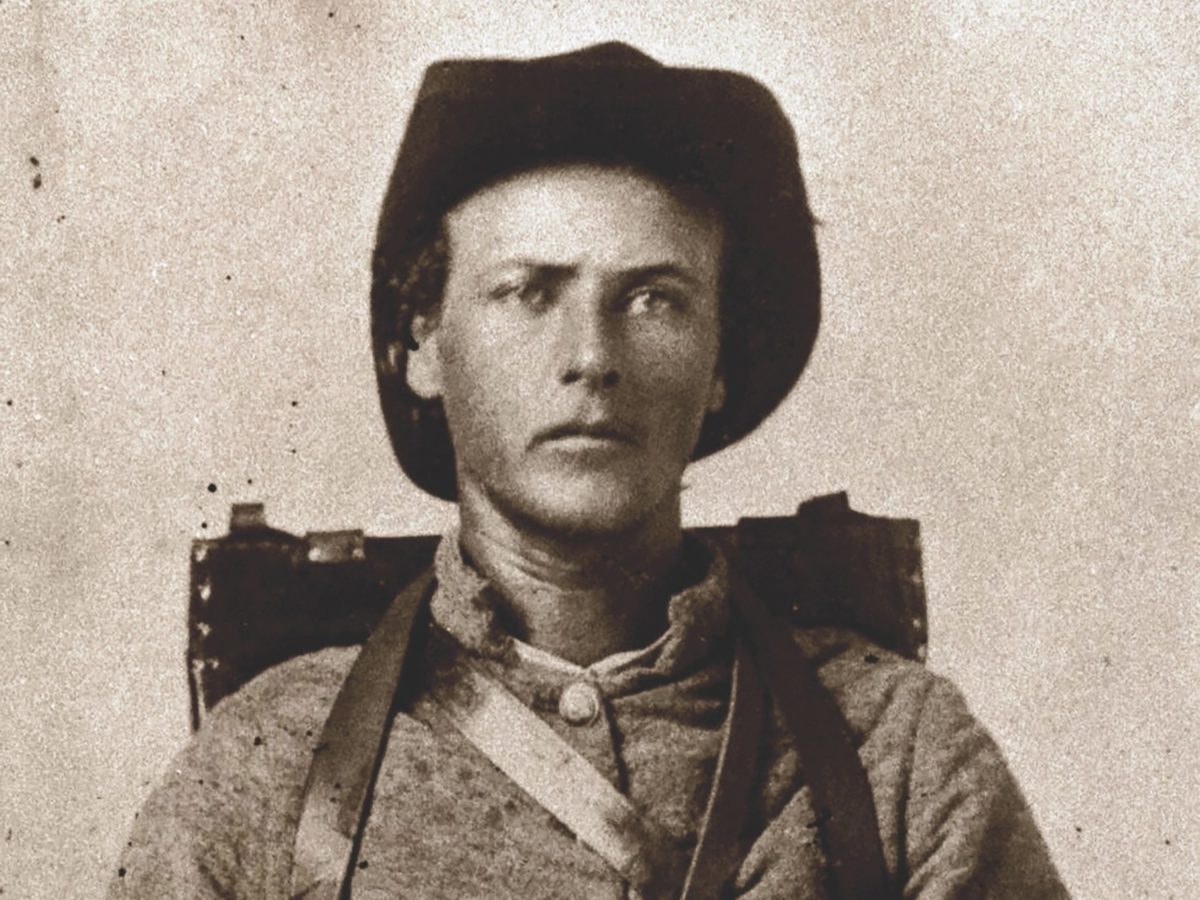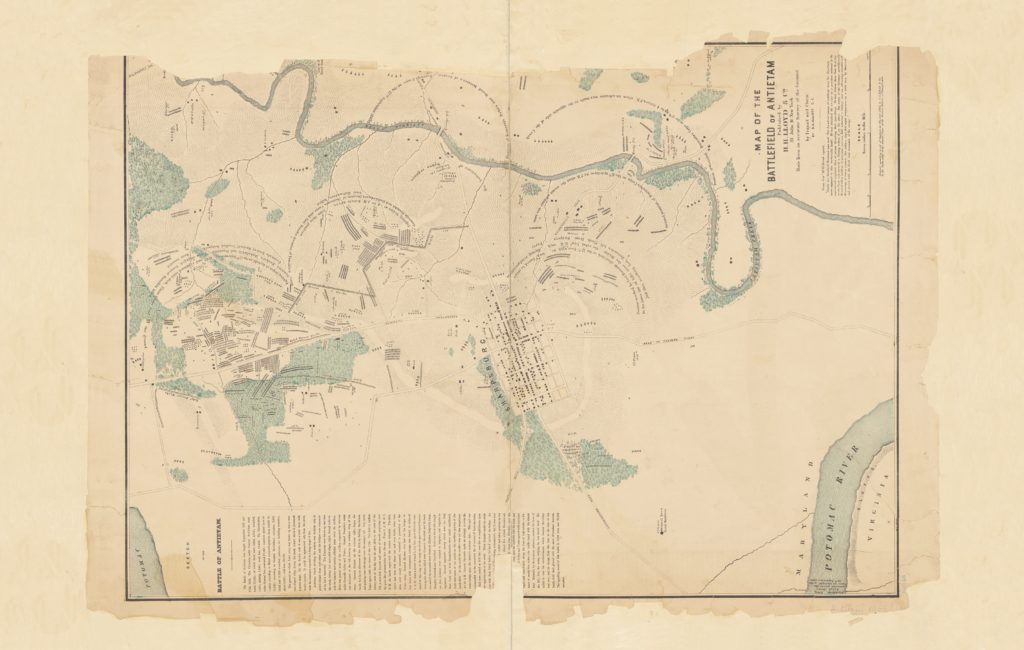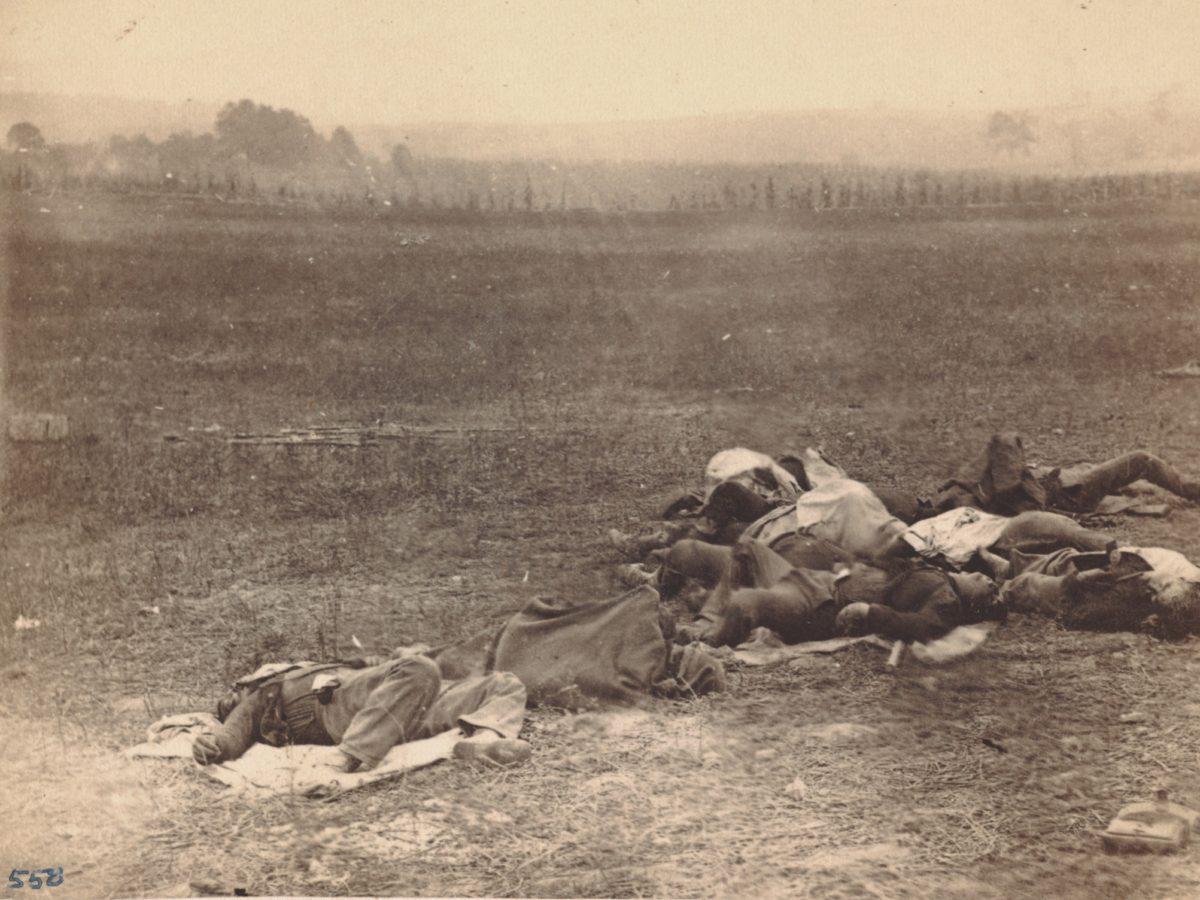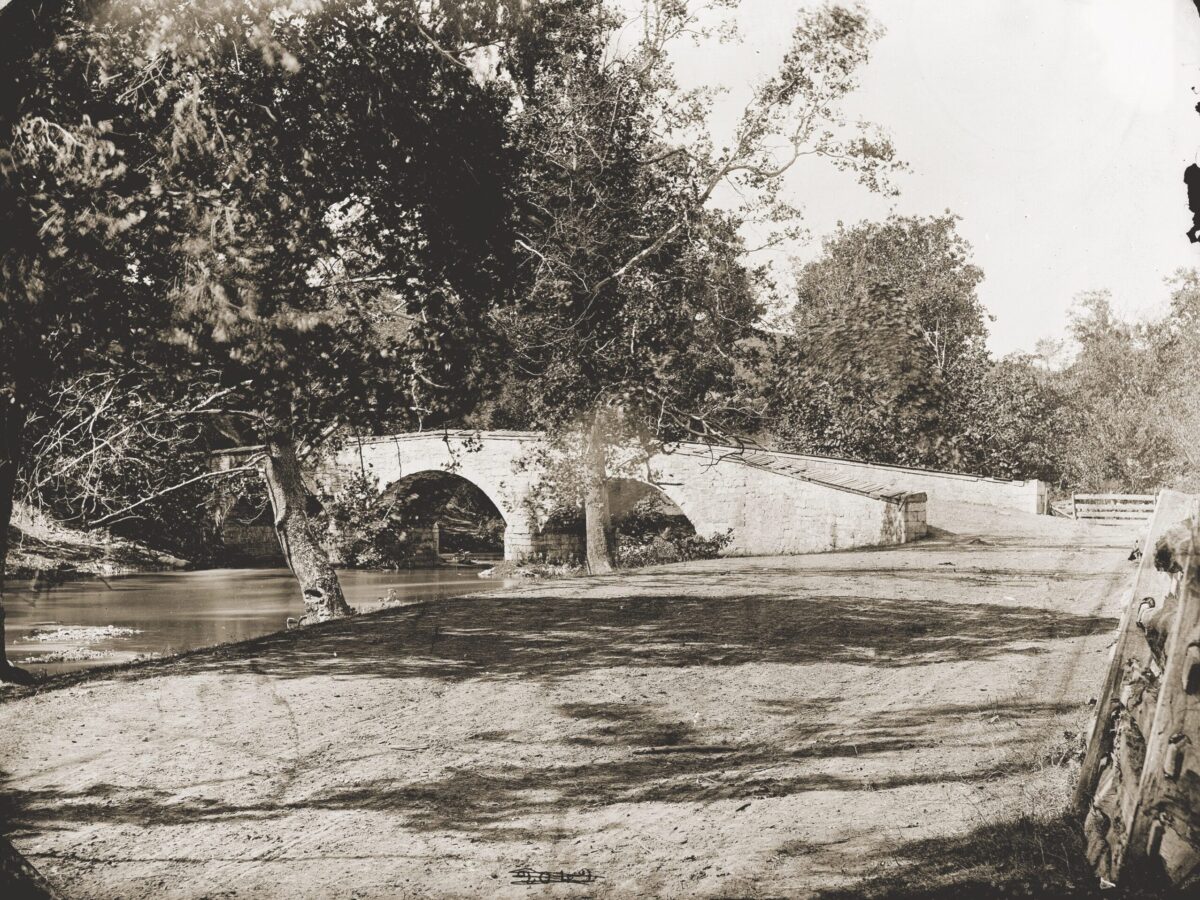On Sunday night, September 14, 1862, Confederate General Robert E. Lee issued orders for his much scattered commands to rally at Sharpsburg, Maryland. His ambitious plans to cut the railroad bridge near Harrisburg, Pennsylvania, had been thwarted by Major General George McClellan‘s unusually quick response to his raid into Maryland. Lee’s Army of Northern Virginia, thinly spread across south-central Maryland and northeastern Virginia, faced the very real threat of being beaten in detail.
All spring and summer the Confederate Army had stymied its blue-frocked adversaries, first in the Peninsula Campaign, where McClellan’s Army of the Potomac was repulsed before Richmond, and then during the summer at Cedar Mountain and Second Manassas, where Maj. Gen. John Pope’s ill-starred Army of Virginia was routed by the swift-marching Rebels.
Now it was Lee who was caught short. Major Generals James Longstreet and D.H. Hill had barely held the passes on South Mountain two days earlier; the heroism of their worn and hungry troops had given Lee time to reunite his army. It was an urgent matter that required Maj. Gen. Thomas J. Jackson to march his command all night from Harpers Ferry. It was a hard march that left stragglers all the way from Harpers Ferry to Sharpsburg–even Stonewall referred to it as ‘severe.’
Recommended for you
The divisions of Longstreet and Hill had arrived first and established their lines on what would be the Confederate right, due west of Antietam Creek and east of Sharpsburg. Major General Lafayette McLaw’s division from Longstreet’s command, assigned to Jackson for the Harpers Ferry siege, had been forced to turn and fight Maj. Gen. William B. Franklin’s VI Corps at Crampton’s Gap; as a result his division would be late in arriving. Major General A.P. Hill’s famed ‘Light Division’ had been assigned the responsibility of paroling Federal prisoners taken at Harpers Ferry and shipping captured war materiel south. It seemed doubtful the division would be able to make it up the following day.
On the morning of Tuesday, September 16, McClellan had nearly 60,000 soldiers facing Lee’s 15,000. His heavy 20-pound Parrott rifles were sending case shot across the creek, feeling out the enemy. As Longstreet ordered a vigorous response– more for bluff than effect–Lee realized his one chance for salvation lay with McClellan’s reverting to his old, timid behavior. McClellan did not disappoint him. Across the creek, the commander of the Federal Army rode about on his horse, Dan Webster, taking the salutes of his admiring infantry and superbly equipped artillery. His boys would pay dearly for their general’s indecisiveness.
By noon, Jackson and Brig. Gen. John Walker began to arrive, taking up the Confederate line on the left along the Hagerstown Pike near Dunker Church, north of town, then sweeping southeasterly to a worn farm lane on the Mumma property a mile away. The rest of the afternoon, well into the evening, Confederate stragglers came in. Neither slackers nor deserters, these were the sick and starving who had been unable to keep up with the swift-marching columns.
Lee’s ranks had been thinned by casualties, sickness and large-scale desertions, but he had the advantage of position. He’d selected an excellent defensive field in which to fight. The lay of the land permitted the Rebels the opportunity to transfer troops under cover and allowed them to select the most advantageous artillery positions.
On the left flank, Maj. Gen. J.E.B. (‘Jeb’) Stuart placed Brig. Gen. Fitz Lee’s cavalry brigade with his three batteries of Captain John Pelham’s Horse Artillery and three additional batteries on an unpretentious hillock known locally as Nicodemus Hill. East of the Hagerstown Pike, Brig. Gen. Evander M. Law’s brigade had taken position in the East Woods. Law sent his videttes well to the north and east, keeping a close eye on the Upper Bridge.
By 10 p.m. the artillery fire had nearly ceased, and only intermittent musketry ravaged the night air. Just after midnight it began to rain, a drizzle at first, then a cloudburst that drenched both armies and made everyone miserable. However, the men of Brig. Gen. John Bell Hood’s division were elated; they had been given permission to withdraw to the West Woods and cook rations. It would be the first time in nearly three days that the case-hardened soldiers would have the opportunity to eat a warm meal.
Throughout the night, the sudden flash of musketry or the roar of cannon deprived everyone of a decent night’s rest. The opposing soldiers made peace with their God, wrote letters to loved ones, and waited. The battle would be joined in the morning.
Between the two armies lay a cornfield owned by David R. Miller. The cornstalks were turning from green to brown, ready to be harvested, 30 acres of corn fodder for Miller’s cattle, perhaps a cash crop that would provide a few of the essentials for his family. Whatever plans Miller had for his corn were destined to go awry; his cornfield would soon be transformed into an altar where men in blue and gray would sacrifice their all for honor, duty, and love of regiment.
Fog shrouded the field the next morning, and artillerists on both sides had to wait until the rising sun had burnt off enough fog to permit sighting. Just after dawn, the Confederate guns at Dunker Church, Nicodemus Hill and the North Woods, and the Federal reserve artillery across Antietam Creek, opened with a cacophonous roar, sounding the knell for America’s bloodiest day.
Brigadier General A.R. Lawton’s division had replaced Hood during the night; to his left, Brig. Gen. John R. Jones’ soldiers took up the line sweeping across the cornfield and Hagerstown Pike into the northern tip of the West Woods. Jackson’s nearly 8,000 troops were evenly matched with Union Maj. Gen. Joseph Hooker’s 8,500 effectives–the Confederate advantage lay with their artillery. Pelham’s guns on Nicodemus Hill could take any massed infantry moving south out of the North Woods in a murderous flanking fire. Colonel S.D. Lee’s guns at Dunker Church would be able to strike them head-on, and both positions would easily be able to bracket any troops within the area of the cornfield. Jackson was quick to understand the importance of Nicodemus Hill and ordered Brig. Gen. Jubal Early to move his brigade in support of the artillery.
The rattle of skirmish fire and the thunderous roar of salvos fired by battalion filled the air as the Union I Corps entered the North Woods. Brigadier General Abner Doubleday’s 1st Division followed his 4th Brigade, commanded by Brig. Gen. John Gibbon, moving parallel with the Hagerstown Pike. On his left, Brig. Gen. James B. Rickett’s 2nd Division followed the 1st Brigade, commanded by Brig. Gen. Abram Duryea. Immediately in the rear, Brig. Gen. George Meade’s 3rd Division stood ready to support the advance.
Pelham’s canoneers quickly got the range on Gibbon’s leading regiments. The 6th Wisconsin began taking heavy fire; a shell burst among the ranks, killing two men and knocking down 11 others. The regiment never faltered, however, closing ranks and continuing forward. Just south of their position, Hooker had detected the flash of sunlight reflecting off bayonets and ordered up two batteries of Federal artillery. Battery F, 1st Pennsylvania Light Artillery, and the Independent Pennsylvania Battery each boasted four 3-inch rifled guns. Lawton’s and Jones’ skirmish line opened on the cannoneers with galling and accurate musket fire that dropped horses and men with fearful rapidity.
Still, the two Federal batteries threw back the Rebel skirmish line, leaving mangled corpses and wounded scattered throughout the cornfield. The way had been cleared, or so the Federal infantry hoped, for an advance, and the order to go forward was sounded by buglers and drummers. Regimental color companies with their prized battle flags took the lead, while taut-faced infantrymen with their kepis and slouch hats pushed hard against their heads, marched deliberately across Mr. Miller’s clover field toward the cornfield and their destiny.
On the right, Gibbon had maneuvered the 4th Brigade, the famed ‘Iron Brigade,’ into an assault formation, with the 6th and 2nd Wisconsin leading and the 7th and 19th Indiana in close support. On Gibbon’s left, Duryea’s brigade debouched from the North Woods nearly at the same time, moving across the clover field purposefully, taking incoming shells and musketry, but still advancing.
Stonewall Jackson faced the foe with only Hood’s division as reserve. In permitting Hood’s withdrawal from the line during the night, Jackson had secured a promise from the brigadier that his command would come without delay when summoned. East of the Hagerstown Pike, Lawton’s brigade of Georgians, commanded by Colonel Marcellus Douglas, followed by Brig. Gen. Harry Hays’ five Louisiana regiments, swept across the southern section of the cornfield toward the Smoketown Road, where Brig. Gen. Issac Trimble’s brigade, commanded by Colonel James A. Walker, held the line all the way to the Mumma Farm Lane. West of the pike, Colonel A.J. Grigsby’s brigade formed a line running west toward the Potomac River, with Colonel B.T. Johnson’s brigade on their left.
The front ranks of Duryea’s Federal brigade came on steadily through the cornfield, with their muskets leveled at the waist. The rear ranks carried their rifles over their shoulders to prevent injuring those in front. All plodded forward with a determination that impressed their Southern foes. Colonel Walter Phelp’s 1st Brigade was closing fast on Gibbon’s boys and the massed Federal formations were easy targets for the Confederate artillery that had long since bracketed the cornfield. The Union soldiers moved forward, heads bent against the torrent of shells and musketry being poured into them, their regimental flags being shot to pieces and friends and messmates knocked down with every step.
Duryea’s three regiments made for the cornfield’s southern edge, wavering with each incoming volley fired into them by the Rebels. Suddenly, Lawton’s troops rose up en masse and fired point-blank into their thinned ranks. The Federals staggered to the left and made for the fence along the Smoketown Road. But Duryea’s brigade was already used up. In its 20-minute journey through the cornfield, the brigade had lost nearly 300 men.
Lieutenant Colonel Edward Bragg’s 6th Wisconsin straddled the pike, with five companies on the west side of the road and the remainder spread eastward. The two Rebel brigades on their right opened a deadly enfilade fire that swept the ranks of Bragg’s exposed troopers. The Southerners were fighting desperately for control of the cornfield. Confederates, individually and in groups, crept through the bloodstained stubble, fog and battlesmoke, laying ambushes, killing at point-blank range, and escaping into the gray-white mist to repeat their deadly game. The fighting became frenzied, neither side knowing when the enemy might suddenly appear out of the fog.
The heavy, close-in fighting completely halted Gibbon’s advance. Jones’ and Grigsby’s brigades moved left and charged to the west side of the pike fence, firing volleys into the 6th Wisconsin’s exposed flank and the forward position of the 2nd Wisconsin. Across the road, in the northern portion of the West Woods, the 7th Wisconsin and 19th Indiana saw their comrades’ predicament and poured a devastating fire into the Confederates. The gray lines were swept with heavy musket and cannon fire. The two Rebel brigades quickly deteriorated, struck from three sides by musketry and artillery, and the order to withdraw was quickly given and carried out.
First Division commander Abner Doubleday ordered Brig. Gen. Marsena Patrick to move his brigade across the pike and drive into the West Woods. As the movement was being made, Patrick picked up the 7th Wisconsin and 19th Indiana, adding weight to the assault.
Jackson’s left and center were in imminent danger of collapse. At great sacrifice, Doubleday’s 1st Division had punched a salient in Jackson’s line, its epicenter in the southwest corner of the cornfield. While this looked propitious to McClellan and his staff as they watched through binoculars from the Pry House across the creek, the fact remained that the Federal position within the salient had not been solidified, and four Confederate brigades were still putting up a stiff resistance.
The fighting in the southwest corner of the cornfield became desperate. The pockets and cartridge pouches of the dead and wounded were ransacked, and soldiers handed muskets to those with better shots at the enemy. The smoke, heat and roar of battle deluged the senses, obliterating all rational thought. Men laughed and giggled, screamed and cried. All sense of time was lost, and even the desire for survival was set aside. All that mattered now was the regiment and its colors.
Lieutenant Colonel Bragg was hit by musketry and severely wounded. Command of the 6th Wisconsin devolved on Major Rufus Dawes, a native of Marietta, Ohio, and a fighting officer if ever there was one. On Dawes’ left, Duryea’s brigade was pulling back from the fence along Smoketown Road through the cornfield–Gibbon’s flank was in the air. Phelp’s 1st Brigade moved up in close support of Gibbon as the Iron Brigade wheeled through the bloodstained cornfield parallel with Hagerstown Pike and swept the brave remnant of Jones’ and Grigsby’s Confederates with a deadly fire. The hard-hit Rebels broke and ran the Union gauntlet toward sanctuary in the West Woods.
Across Hagerstown Pike, Jackson sat on his horse in perfect Christian peace as bullets and shell fragments whizzed and whined about him. Couriers and staff officers ran to and from their commander as he sat immobile, seemingly immune to human frailties. Hood would have to go in–he was the only reserve available.
Lawton ordered Hays’ brigade into the gap left by Duryea’s withdrawal. Hays’ men plowed through the cornfield and fired an enfilading volley into the thinning ranks of the 2nd and 6th Wisconsin. The combined efforts of Hays’ and Lawton’s infantry halted the Federal advance and stabilized Jackson’s front.
Hays’ Louisiana Brigade had done its usual ferocious fighting in support of Lawton, but their right-wheel maneuver had exposed their right flank and the fighting had depleted their ammunition pouches. The brigade was helpless when Colonel Richard Coulter’s 3rd Brigade came storming out of the corn stubble, too late to help Duryea, but determined to sweep the field of Rebels. The Federals’ opening volley hit Hays’ line, piling corpses one atop the other. One of the casualties was Colonel Henry Strong, commanding the 6th Louisiana, who was killed while mounted on his beautiful horse. An officer running to his assistance was hit twice, and the command was forced to withdraw, leaving the colonel’s body and possessions behind. A Union infantryman commandeered the colonel’s gloves, and following the battle Alexander Gardner, famed Civil War photographer, captured the colonel’s dead horse for posterity.
It was now just before 7 a.m. Doubleday’s 1st Division had been halted on the south end of the cornfield near Hagerstown Pike, while on his left Rickett’s 2nd Division was being fed into the battle piecemeal and taking a terrible pounding from the Confederates who’d been able to rush troops to trouble spots.
Smoke from the artillery and musketry inundated the field. Soldiers in the thick of the fight were covered with the black, greasy stain of burnt powder, which gave a deadly, ghostlike appearance to the participants. The pungent smell of trampled vegetation, sweat, powder and bodies imposed a surrealistic perception that survivors carried with them the rest of their lives.
Above Dunker Church all that was left of Jackson’s line was a remnant of the old, trusted Stonewall Brigade, under the watchful eye of ‘Old Jack’ himself. The division commander, General Jones, was with the brigade, trying desperately to hold when he was wounded by shrapnel, and command of the division devolved on Brig. Gen. William E. Starke. Starke was moving his brigade out of the West Woods in support of Jackson when he was mortally wounded, and command of the division devolved in turn on Colonel Grigsby. The assault of the two Confederate brigades petered out under a hail of shot and ball on the west side of the pike, where the infantrymen formed behind the fence bordering the road. They fell there by the score, and within a short time their position became untenable and they withdrew into the West Woods.
Gibbon’s and Phelp’s men had checked the Rebel thrust into their flank, but had taken severe losses in return. Now they too were low on ammunition and forced to scour the cartridge pouches of the dead and wounded. Doubleday’s entire division was nearly used up, and supports were not at hand.
Deep in the West Woods, Hood’s little division was still busy preparing rations. Normally this wasn’t an unusual act for Civil War soldiers, especially Rebels, but these men were literally starving. Pressed by forced marches and heavy fighting the past few days, the division had long since eaten up all their victuals and were now about as hungry as heavily armed men could get. But Hood had given his word to Jackson to bring up the command as soon as the request was made and now Jackson was calling. Hood gave the order and the two brigades began to re-form. Men threw down half-cooked pones and bacon or shoved the beginnings of greasy fatback biscuits into their mouths as they moved out.
Hood’s 2,300 men swarmed into the field north of their position at Dunker Church. They halted momentarily and volleyed into Gibbon’s line, reloaded and fired again. Hood’s appearance on the field broke the Federals’ back, and they began to withdraw. The bravest gathered up wounded messmates and fallen battle flags and returned fire as best they could. Evander Law’s brigade swept northeastward with its right anchored on Smoketown Road by the 4th Alabama. On Law’s left and rear, Colonel William T. Wofford’s renowned Texas Brigade came on with two regiments, picking off fleeing Yankees while the 18th Georgia, 1st Texas and Hampton’s Legion charged due north, firing into the enemy as they came.
On the east side of the cornfield the two Union brigades were in full retreat. The 12th Massachusetts, which had fought bravely, took a staggering 67 percent casualties in less than 30 minutes. I Corps gains had been swiftly wiped out, and all that stood between it and annihilation was Meade’s 3rd Division.
Hurriedly, Meade got Robert Anderson’s 3rd Brigade formed along a fence north of the cornfield, with its muskets resting on the bottom rail, just as Hood was ordering Colonel P.A. Works’ 1st Texas over to the left to support Hampton’s Legion. Works soon lost control of the 1st Texas as the men outraced the line and charged straight for Anderson’s position. As the Texans cleared the battle smoke, Anderson ordered, ‘Fire!’ and the brigade’s musketry swept the Texans with deadly accuracy, while Union 12-pounders struck them on the flank, halting the charge and driving them to ground.
Meanwhile, north of the cornfield, Major Dawes was busy rallying the survivors of his beloved 6th Wisconsin. The regimental colors were brought up, the line eagerly formed, and the men sent forward on the double-quick. Dawes’ charge cleared the Texans, who had advanced to within 45 feet of the Union guns, and he ordered several to stay and help the artillerists while the 6th moved on toward the pike. Meade got his remaining two brigades, Colonel Thomas Gallagher’s 3rd and Colonel Albert Magilton’s 2nd, in line and pushed them straight for the 1st Texas. A few hundred yards southwest, someone retrieved the four Federal regiments that 30 minutes earlier had sallied into the West Woods, and directed them toward the left flank. The 7th Wisconsin and 19th Indiana led the assault, supported by the 35th and 21st New York. Their combined musketry soon swept the left flank of the 18th Georgia, Hampton’s Legion and the 4th Texas.
On the northwest corner of the cornfield, the 1st Texas lay dying. The regiment’s casualties were fast approaching 50 percent as the Texans rose up and fired, point-blank, into the 9th Pennsylvania Reserves. The entire color guard was shot down, while all along their line Rebel artillery walked salvos of case shot. The Federal line buckled and swayed but somehow kept coming, closing over their dead and wounded, pressed by the screams of those closing up their files. Nearly out of ammunition, Work tried to get permission from Hood to withdraw, but couldn’t reach him.
Work could see that his supports were under attack and withdrawing and that if he was going to get out at all it would have to be now. He gave the order just as the 9th, 11th and 12th Pennsylvania Reserves fired a volley into his decimated line. Of the 226 soldiers he’d led in the assault, 186 had fallen dead or wounded within 45 minutes. South of his position, the 18th Georgia, Hampton’s Legion and the 4th Texas were also quitting the field. The command had given all that they had–of the 858 effectives in the Texas Brigade, 472 would be listed as casualties in what may well have been the grandest charge of the entire war.
The fearless Butternuts of the 6th North Carolina, the famed Bloody Sixth, held the Confederate right, anchored in the northeastern portion of the East Woods. Hidden in the bushes and among the trees, the 6th awaited the fast approaching 8th Pennsylvania Reserves and at a range of 30 feet opened a fusillade that swept the Pennsylvanians’ ranks and knocked down half the regiment. The Federal assault was quickly renewed, and Law’s left was uncovered, rendering his line untenable and forcing his withdrawal. With Law’s retreat the cornfield was ceded to the I Corps.
Both Jackson and Hooker had one brigade left that hadn’t been heavily used–beyond that the flower of their commands lay strewn among the blood-splattered corn stubble, the fields north and south of the cornfield, the Hagerstown Pike and the East Woods. The field of honor had become a sacrificial slaughter pen, with the cornfield as its gory hub.
Major General Joseph K.F. Mansfield had officially taken over command of the Union XII Corps two days earlier. The corps, Maj. Gen. Nathaniel Bank’s old command, had suffered mightily at the hands of Jackson a few months earlier in the Shenandoah Valley, and its losses had been made up with green regiments, some with only 30 days training, and most from Pennsylvania.
While Mansfield slowly maneuvered the corps toward the front, General D.H. Hill, commanding the Confederate center, led Brig. Gen. Roswell Ripley’s brigade into the void created by the withdrawl of Hood’s decimated division. In the East Woods, the Confederates had a hodgepodge collection of regiments waiting in ambush for any unsuspecting Federals who might wander into their field of fire. They didn’t have to wait long.
Brigadier General Alpheus Williams’ 1st Division led the advance, followed by Brig. Gen. George S. Greene’s 2nd Division. Mansfield had the corps marching in columns of division, which allowed for swift movement but left the command practically defenseless in the face of attack. Williams split his division, sending Brig. Gen. Samuel Crawford’s 1st Brigade due south toward the East Woods and Brig. Gen. George Gordon’s 3rd Brigade toward the North Woods.
Crawford’s six regiments pressed toward the East Woods. The 124th New York, one of the ‘raw’ regiments, inadvertently moved westward and lost touch with the rest of the brigade. The 10th Maine, a veteran outfit, held the lead, and though still in column was returning fire on Rebel skirmishers busily harassing their every step. The ubiquitous Joe Hooker came riding up and shouted to Colonel George Beal, commanding the 10th, that they must hold the woods at all costs. Immediately, Beal disobeyed Mansfield’s order to stay in column and ordered the command to advance by ‘regimental front.’
The Rebels challenging Beal’s 10th Maine were from the 21st Georgia, commanded by Captain James Nisbet. Nisbet’s plan was to fire and fall back, drawing the 10th into an ambush. Accordingly, the 10th was drawn into a slight depression when all of the Georgians’ muskets cracked in the sultry morning air, driving the New Englanders into the ground and halting their advance. Meanwhile, the rest of Crawford’s brigade pressed on.
The 46th Pennsylvania and 28th New York debouched from the East Woods just above the fighting and poured into Miller’s field, while the 128th Pennsylvania, yet another green regiment, came up on the right.
Just as the 128th broke through the tree line of the East Woods, the 4th Alabama poured a devastating fire into their ranks, killing their colonel and second-in-command. Leaderless and in combat for the first time, the Pennsylvanians milled aimlessly about the field, taking killing fire.
At the same time, Ripley got his entire brigade into line of battle after they’d moved north of Smoketown Road. They were moving at the double-quick, making for the southern end of the cornfield, when four Union regiments, the 27th Indiana, 2nd Massachusetts, Pennsylvania Zouaves d’Afrique and 3rd Wisconsin, halted on the northern edge of the cornfield and waited for the 128th Pennsylvania to clear their field of fire. Ripley’s left opened first, driving the remnant of the 19th Indiana northward along Hagerstown Pike and killing the regiment’s commander, Lt. Col. Alois Bachman.
Ripley’s assault struck Meade’s Pennsylvanians and initially drove them back. But Ripley’s right was exposed in the attack, and Crawford’s 12th Corps brigade fired coordinated volleys into his exposed flank, splintering and fragmenting the attack. Williams and officers from other regiments finally got the 128th Pennsylvania into a good line, and when the 3rd North Carolina advanced on them the soldiers, just a few weeks from civilian life, opened fire, sweeping the Rebel line with accurate and murderous musketry.
On the 128th’s left, among the trees and bushes of the East Woods, the 10th Maine was making headway. Fighting with an open front, advancing a few feet at a time, the New Englanders were having some success shoving the three Confederate regiments out of the woods. Captain Ike Turner, commanding the 5th Texas, tried unsuccessfully to get reinforcements or else obtain permission to withdraw from the woods, but could not reach Hood. Meanwhile, the 4th Alabama shot off its last rounds and made for the safety of the West Woods, while the 6th North Carolina moved into position to the left of the 21st Georgia, still contesting the Federal advance.
After leading Ripley’s brigade into the cornfield, D.H. Hill returned to the Mumma Farm Lane and ordered Colonel Alfred Colquitt’s brigade into the battle. As Colquitt’s fine brigade, flushed with victory over Gibbon’s Iron Brigade two days earlier at Turner’s Gap, advanced through the cornfield in support of Ripley, Colonel D.K. McRae’s brigade moved northward parallel to the East Woods, firing as it advanced. Just as McRae’s men entered the cornfield, the 28th Pennsylvania emerged from the woods and swept McRae’s line with a devastating enfilading fire. McRae reported that ‘this produced great confusion. . . it [the brigade] commenced to break and a general panic ensued.’
In the meantime, Colquitt’s infantry was fully engaged. Most of Ripley’s brigade had been knocked down or forced from the field. Two regiments, the 1st and 3rd North Carolina, remained intact, supporting Colquitt and allowing him time to prepare the charge. The colonel got his lines dressed under a murderous crossfire and ordered the command forward. The charge swept northwesterly across the cornfield, picking up speed and ferocity as soldiers were cut down by ball and shell. The battle lines closed over the fallen as the colors moved across the bloodstained cornfield.
On Colquitt’s left, the 13th Alabama struck the 124th Pennsylvania, while on his right the 6th Georgia collided with the 5th Ohio. The Ohioans and Georgians piled into each other so swiftly and furiously that after firing off a round they grappled with muskets, knives and fists. The Ohioans prevailed, driving the Georgians out of the East Woods and into the eastern portion of the cornfield. The 7th and 66th Ohio advanced with the 5th as Colquitt’s line passed across their front.
The 2nd Massachusetts and Pennsylvania Zouaves d’Afrique, posted at the Miller Farm, now formed a line just south of Miller’s backyard and went on the double-quick into the smoke-filled cornfield. On their left, the 3rd Wisconsin and 27th Indiana were hit with well-aimed musketry by the 27th Georgia, but held their line and advanced with the Zouaves.
Not only had Colquitt’s charge been broken, but now he was hard pressed on his front. Unsupported, its ranks being thinned every second, Collquitt’s brigade was deprived of choices. The matter became a question solely of survival, and the Southerners broke into small groups and ran the gauntlet in much the same manner as their fellow Confederates had done earlier. Tears of rage and frustration streamed down Colquitt’s cheeks, but to no avail. The rout could not be halted. They had given their all, just as their predecessors had, but the Army of the Potomac had finally seized Mr. Miller’s cornfield.
This article was written by Robert C. Cheeks and originally appeared in the September 1998 issue of America’s Civil War. For more great articles be sure to subscribe to America’s Civil War magazine today!

